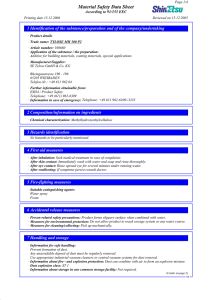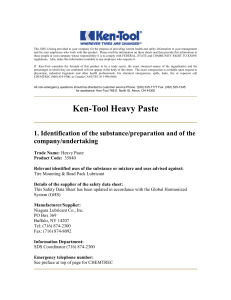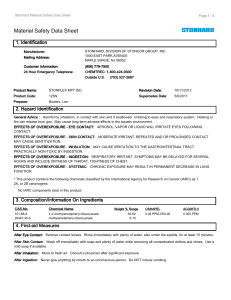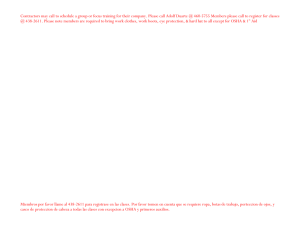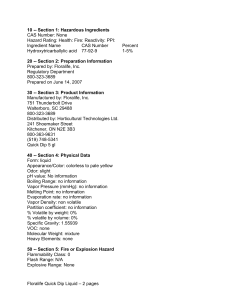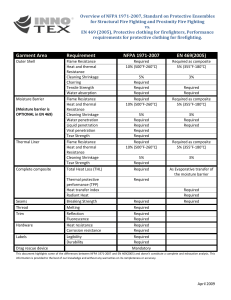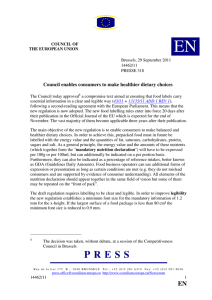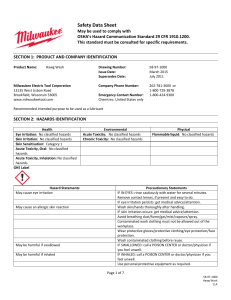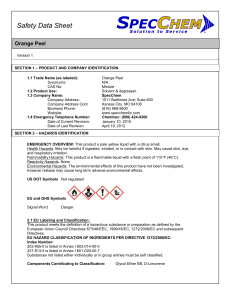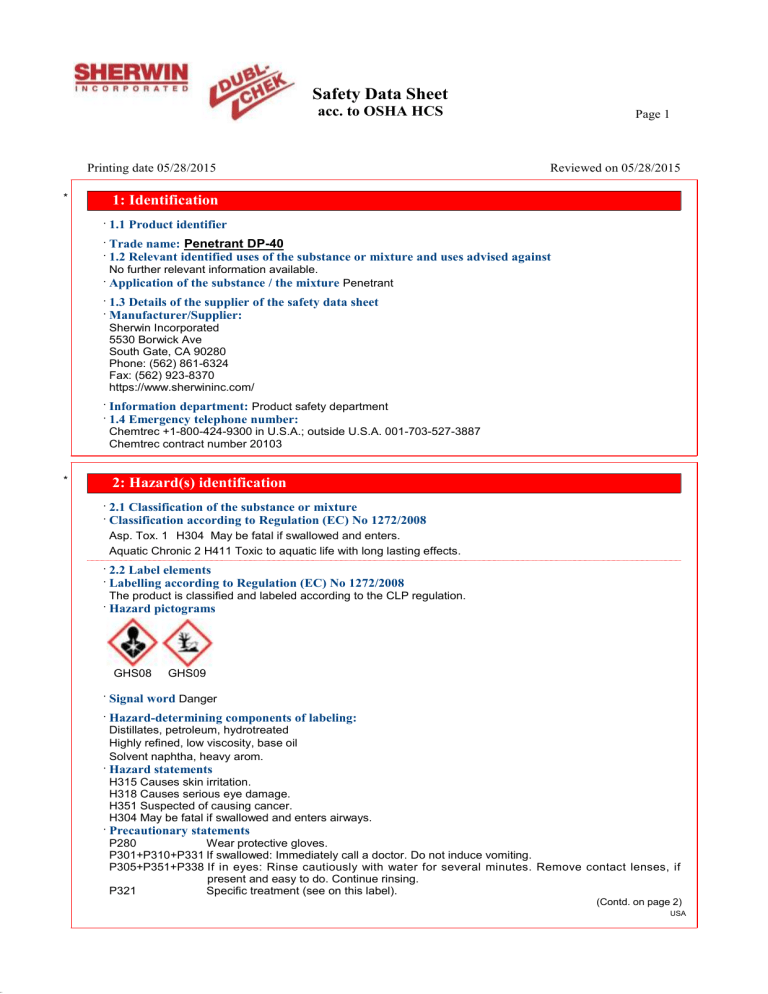
40.0 Safety Data Sheet acc. to OSHA HCS Printing date 05/28/2015 * Page 1 Reviewed on 05/28/2015 1: Identification · 1.1 Product identifier · Trade name: Penetrant DP-40 · 1.2 Relevant identified uses of the substance or mixture and uses advised against No further relevant information available. · Application of the substance / the mixture Penetrant · 1.3 Details of the supplier of the safety data sheet · Manufacturer/Supplier: Sherwin Incorporated 5530 Borwick Ave South Gate, CA 90280 Phone: (562) 861-6324 Fax: (562) 923-8370 https://www.sherwininc.com/ · Information department: Product safety department · 1.4 Emergency telephone number: Chemtrec +1-800-424-9300 in U.S.A.; outside U.S.A. 001-703-527-3887 Chemtrec contract number 20103 * 2: Hazard(s) identification · 2.1 Classification of the substance or mixture · Classification according to Regulation (EC) No 1272/2008 Asp. Tox. 1 H304 May be fatal if swallowed and enters. Aquatic Chronic 2 H411 Toxic to aquatic life with long lasting effects. · 2.2 Label elements · Labelling according to Regulation (EC) No 1272/2008 The product is classified and labeled according to the CLP regulation. · Hazard pictograms GHS08 GHS09 · Signal word Danger · Hazard-determining components of labeling: Distillates, petroleum, hydrotreated Highly refined, low viscosity, base oil Solvent naphtha, heavy arom. · Hazard statements H315 Causes skin irritation. H318 Causes serious eye damage. H351 Suspected of causing cancer. H304 May be fatal if swallowed and enters airways. · Precautionary statements P280 Wear protective gloves. P301+P310+P331 If swallowed: Immediately call a doctor. Do not induce vomiting. P305+P351+P338 If in eyes: Rinse cautiously with water for several minutes. Remove contact lenses, if present and easy to do. Continue rinsing. P321 Specific treatment (see on this label). (Contd. on page 2) USA 40.0 Safety Data Sheet acc. to OSHA HCS Printing date 05/28/2015 Page 2 Reviewed on 05/28/2015 Trade name: Penetrant DP-40 (Contd. of page 1) P405 P501 Store locked up. Dispose of contents/container in accordance with local/regional/national/international regulations. · Classification system: · NFPA ratings (scale 0 - 4) 2 1 Health = 2 Fire = 1 Reactivity = 0 0 · HMIS-ratings (scale 0 - 4) HEALTH 2 FIRE 1 REACTIVITY 0 Health = 2 Fire = 1 Reactivity = 0 · 2.3 Other hazards · Results of PBT and vPvB assessment · PBT: Not applicable. · vPvB: Not applicable. * 3: Composition/information on ingredients · 3.2 Chemical characterization: Mixtures · Description: Mixture of the substances listed below with nonhazardous additions. · Dangerous components: CAS: 64742-47-8 EINECS: 265-149-8 None supplied CAS 64742-94-5 Distillates (petroleum), hydrotreated light 25-50% Highly refined, low viscosity, base oil Solvent naphtha, heavy arom. 25-50% 1-10% · Most important ingredients CAS: 64742-47-8 Distillates (petroleum), hydrotreated light EINECS: 265-149-8 None supplied Highly refined, low viscosity, base oil CAS 64742-94-5 Solvent naphtha, heavy arom. 25-50% 25-50% 1-10% · Additional information: Metabolic studies on some Azo-dyes have detected reduction of azo bonds to aromatic amines. It is prudent to assume that the product could metabolize to o-toluidine, which have been identified as animal carcinogens. * 4: First-aid measures · 4.1 Description of first aid measures · After inhalation: Supply fresh air. If required, provide artificial respiration. Keep patient warm. Consult doctor if symptoms persist. In case of unconsciousness place patient stably in side position for transportation. (Contd. on page 3) USA 40.0 Safety Data Sheet acc. to OSHA HCS Printing date 05/28/2015 Page 3 Reviewed on 05/28/2015 Trade name: Penetrant DP-40 (Contd. of page 2) Take affected persons into fresh air and keep quiet. · After skin contact: Immediately wash with water and soap and rinse thoroughly. If skin irritation continues, consult a doctor. · After eye contact: Rinse opened eye for several minutes under running water. Then consult a doctor. · After swallowing: Do not induce vomiting; immediately call for medical help. Clean mouth with water A person vomiting while lying on their back should be turned onto their side. Aspiration hazard if swallowed - can enter lungs and cause damage · 4.2 Most important symptoms and effects, both acute and delayed No further relevant information available. · 4.3 Indication of any immediate medical attention and special treatment needed No further relevant information available. 5: Fire-fighting measures · 5.1 Extinguishing media · Suitable extinguishing agents: Water haze Foam ABC powder · For safety reasons unsuitable extinguishing agents: Water spray, it may spread fire. · 5.2 Special hazards arising from the substance or mixture Carbon monoxide and carbon dioxide · 5.3 Advice for firefighters · Protective equipment: Wear self-contained respiratory protective device. Wear fully protective suit. * 6: Accidental release measures · 6.1 Personal precautions, protective equipment and emergency procedures Wear protective equipment. Keep unprotected persons away. Ensure adequate ventilation · 6.2 Environmental precautions: Do not allow to enter sewers/ surface or ground water. · 6.3 Methods and material for containment and cleaning up: Absorb with liquid-binding material (sand, diatomite, acid binders, universal binders, sawdust). Dispose contaminated material as waste according to item 13. Ensure adequate ventilation. Collect liquid in an appropriate container or absorb with an inert material such as vermiculite, dry sand, or earth; DO NOT use combustible materials. Place in a chemical waste container. · 6.4 Reference to other sections See Section 7 for information on safe handling. See Section 8 for information on personal protection equipment. See Section 13 for disposal information. * 7: Handling and storage · 7.1 Precautions for safe handling Prevent formation of aerosols. (Contd. on page 4) USA 40.0 Page 4 Safety Data Sheet acc. to OSHA HCS Printing date 05/28/2015 Reviewed on 05/28/2015 Trade name: Penetrant DP-40 · Information about protection against explosions and fires: Do not eat, drink or smoke when using this product. Handle in accordance with good industrial hygiene and safety practice. Keep away from open flames, hot surfaces and sources of ignition. Containers may be hazardous when empty since residue liquid and vapors may be present (Contd. of page 3) 7.2 Conditions for safe storage, including any incompatibilities · Storage: Keep containers tightly closed in a dry, cool and well-ventilated place. · Requirements to be met by storerooms and receptacles: No special requirements. · Information about storage in one common storage facility: Not required. · Further information about storage conditions: None. · 7.3 Specific end use(s) No further relevant information available. * 8: Exposure controls/personal protection · Additional information about design of technical systems: No further data; see item 7. · 8.1 Control parameters · Components with limit values that require monitoring at the workplace: The product does not contain any relevant quantities of materials with critical values that have to be monitored at the workplace. ACGIH TLV OSHA PEL 3 3 Highly refined, low viscosity, base oil 5 mg/m as mist 5 mg/m as mist · Additional information: The lists that were valid during the creation were used as basis. · 8.2 Exposure controls · Personal protective equipment: · General protective and hygienic measures: Keep away from foodstuffs, beverages and feed. Immediately remove all soiled and contaminated clothing. Wash hands before breaks and at the end of work. Avoid contact with the eyes. · Breathing equipment: In case of brief exposure or low pollution use respiratory filter device. In case of intensive or longer exposure use respiratory protective device that is independent of circulating air. Ventilation System: A system of local or general exhaust is recommended to keep employee exposure below the airborne exposure limits. If exposure limit is exceeded use organic vapor respirator (type A), or self contained breathing apparatus. . · Protection of hands: Protective gloves The glove material has to be impermeable and resistant to the product/ the substance/ the preparation. Selection of the glove material on consideration of the penetration times, rates of diffusion and the degradation · Material of gloves The selection of the suitable gloves does not only depend on the material, but also on further marks of quality and varies from manufacturer to manufacturer. As the product is a preparation of several substances, the resistance of the glove material can not be calculated in advance and has therefore to be checked prior to the application. · Penetration time of glove material The exact break through time has to be found out by the manufacturer of the protective gloves and has to be observed. (Contd. on page 5) USA 40.0 Page 5 Safety Data Sheet acc. to OSHA HCS Printing date 05/28/2015 Reviewed on 05/28/2015 Trade name: Penetrant DP-40 (Contd. of page 4) · Eye protection: Safety glasses Tightly sealed goggles · Body protection: Protective work clothing Use protective suit. * 9: Physical and chemical properties · 9.1 Information on basic physical and chemical properties · General Information · Appearance: Form: Fluid Color: Red · Odor: Characteristic · Odour threshold: Not determined. · pH-value: Not determined. · Change in condition Melting point/Melting range: Boiling point/Boiling range: Flash point: Not determined. Not determined > 93 °C (> 199 °F) (ASTM D-93) · Flammability (solid, gaseous): Not applicable. · Ignition temperature: Not determined · Decomposition temperature: Not determined. · Auto igniting: Product is not selfigniting. · Danger of explosion: Product does not present an explosion hazard. · Explosion limits: Lower: Upper: Not determined Not determined · Vapor pressure: Not determined. · Density at 20 °C (68 °F): · Relative density 0.88 g/cm³ (7.3 lbs/gal) (ASTM D-1298) Not determined. · Vapour density Not determined. · Evaporation rate Not determined. · Solubility in / Miscibility with Water: Not soluble. · Partition coefficient (n-octanol/water): Not determined. · Viscosity: Dynamic: Not determined. (Contd. on page 6) USA 40.0 Page 6 Safety Data Sheet acc. to OSHA HCS Printing date 05/28/2015 Reviewed on 05/28/2015 Trade name: Penetrant DP-40 Kinematic: · 9.2 Other information (Contd. of page 5) Not determined. No further relevant information available. 10: Stability and reactivity · 10.1 Reactivity · 10.2 Chemical stability · Thermal decomposition / conditions to be avoided: No decomposition if used according to specifications. · 10.3 Possibility of hazardous reactions No dangerous reactions known. · 10.4 Conditions to avoid No further relevant information available. · 10.5 Incompatible materials: Strong oxidizing agents, Strong acids, Strong bases · 10.6 Hazardous decomposition products: No dangerous decomposition products known. * 11: Toxicological information · 11.1 Information on toxicological effects · Acute toxicity: Information on hazardous ingredients · Primary irritant effect: · on the skin: No irritant effect. · on the eye: Strong irritant with the danger of severe eye injury . swallowed: Risk of entering lungs if aspirated. · Sensitization: No sensitizing effects known. · Additional toxicological information: LD50 Oral (rat) LD50 Dermal(rat/rabbit) Distillates (petroleum), hydrotreated light >5000 mg/kg rabbit 3.7 Max score is 8.0 Highly refined, low viscosity, base oil >2000 mg/kg >2000 mg/kg Di-isononylphthalate: Assessment of repeated dose toxicity: Repeated exposure to high doses of the substance causes reversible liver changes in rodents. According to present knowledge, these effects do not occur in man. Effects on the kidney of male rats were detected after repeated exposure. These effects are specific for the male rat and are known to be of no relevance to humans. Carcinogenic categories · IARC (International Agency for Research on Cancer) None of the ingredients is listed. · NTP (National Toxicology Program) None of the ingredients is listed. · OSHA-Ca (Occupational Safety & Health Administration) None of the ingredients is listed. * 12 12: Ecological information 12.1 Toxicity · Aquatic toxicity: Information on hazardous ingredients No further relevant information available. (Contd. on page 7) USA 40.0 Page 7 Safety Data Sheet acc. to OSHA HCS Printing date 05/28/2015 Reviewed on 05/28/2015 Trade name: Penetrant DP-40 (Contd. of page 6) · 12.2 Persistence and degradability No further relevant information available. · 12.3 Bioaccumulative potential No further relevant information available. · 12.4 Mobility in soil No further relevant information available. · Ecotoxical effects: · Remark: Toxic for fish · Additional ecological information: · General notes: Do not allow product to reach ground water, water course or sewage system. Danger to drinking water if even small quantities leak into the ground. · 12.5 Results of PBT and vPvB assessment · PBT: Not applicable. · vPvB: Not applicable. · 12.6 Other adverse effects No further relevant information available. * 13: Disposal considerations · 13.1 Waste treatment methods · Recommendation: Must not be disposed of together with household garbage. Do not allow product to reach sewage system. Waste/ unused products Collect all waste in suitable and labelled containers and dispose according to local legislation. · Uncleaned packagings: · Recommendation: Waste / used products Waste products and empty packages dispose of in accordance with local regulations. Empty containers may contain flammable residue and vapors. · Recommended cleansing agent: Water, if necessary with cleansing agents. * 14: Transport information · 14.1 UN-Number · DOT, ADR, IMDG, IATA not applicable · 14.2 UN proper shipping name · DOT, ADR, IMDG, IATA not applicable · 14.3 Transport hazard class(es) · DOT, ADR, IMDG, IATA · Class not applicable · 14.4 Packing group · DOT, ADR, IMDG, IATA not applicable (Contd. on page 8) USA 40.0 Page 8 Safety Data Sheet acc. to OSHA HCS Printing date 05/28/2015 Reviewed on 05/28/2015 Trade name: Penetrant DP-40 (Contd. of page 7) · 14.5 Environmental hazards: · Marine pollutant: No · 14.6 Special precautions for user Not applicable. · 14.7 Transport in bulk according to Annex II of MARPOL73/78 and the IBC Code * Not applicable. 15: Regulatory information · 15.1 Safety, health and environmental regulations/legislation specific for the substance or mixture · Sara · Section 355 (extremely hazardous substances): None of the ingredient is listed. Section 311/312 Acute health · Section 313 (Specific toxic chemical listings): 91-20-3 Naphthalene · TSCA (Toxic Substances Control Act): All ingredients are listed. · Proposition 65 · Chemicals known to cause cancer: 91-20-3 Naphthalene 28553-12-0 Di-isononylphthalate · .Chemicals known to cause reproductive toxicity for females: None of the ingredients is listed. · Chemicals known to cause reproductive toxicity for males: None of the ingredients is listed. · Chemicals known to cause developmental toxicity: None of the ingredients is listed. · Cancerogenity categories · EPA (Environmental Protection Agency) None of the ingredients is listed. · TLV (Threshold Limit Value established by ACGIH) None of the ingredients is listed. · NIOSH-Ca (National Institute for Occupational Safety and Health) None of the ingredients is listed. · 15.2 Chemical safety assessment: A Chemical Safety Assessment has not been carried out. * 16: Other information This information is based on our present knowledge. However, this shall not constitute a guarantee for any specific product features and shall not establish a legally valid contractual relationship. · Contact: Sherwin Incorporated · Date of preparation / last revision 05/28/2015 / · Abbreviations and acronyms: RID: Règlement international concernant le transport des marchandises dangereuses par chemin de fer (Regulations Concerning the International Transport of Dangerous Goods by Rail) IATA-DGR: Dangerous Goods Regulations by the "International Air Transport Association" (IATA) (Contd. on page 9) USA 40.0 Page 9 Safety Data Sheet acc. to OSHA HCS Printing date 05/28/2015 Reviewed on 05/28/2015 Trade name: Penetrant DP-40 (Contd. of page 8) ICAO: International Civil Aviation Organisation ICAO-TI: Technical Instructions by the "International Civil Aviation Organisation" (ICAO) DOT: US Department of Transportation GHS: Globally Harmonised System of Classification and Labelling of Chemicals ACGIH: American Conference of Governmental Industrial Hygienists EINECS: European Inventory of Existing Commercial Chemical Substances ELINCS: European List of Notified Chemical Substances CAS: Chemical Abstracts Service (division of the American Chemical Society) NFPA: National Fire Protection Association (USA) HMIS: Hazardous Materials Identification System (USA) VOC: Volatile Organic Compounds (USA, EU) Skin Irrit. 2: Skin corrosion/irritation, Hazard Category 2 Eye Dam. 1: Serious eye damage/eye irritation, Hazard Category 1 Carc. 2: Carcinogenicity, Hazard Category 2 Asp. Tox. 1: Aspiration hazard, Hazard Category 1 · * Data compared to the previous version altered. USA

